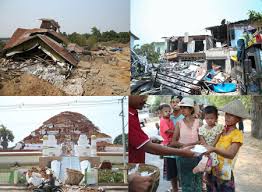 London, Apr 5: Myanmar was struck by the most devastating earthquake in its history. The disaster reduced much of Mandalay, the country’s second-largest city, to rubble. Nay Pyi Taw, the administrative capital, and several towns across central Myanmar also suffered massive destruction.
London, Apr 5: Myanmar was struck by the most devastating earthquake in its history. The disaster reduced much of Mandalay, the country’s second-largest city, to rubble. Nay Pyi Taw, the administrative capital, and several towns across central Myanmar also suffered massive destruction.Beyond the immediate devastation, this earthquake has amplified Myanmar’s already precarious situation. Even before the disaster, Myanmar was home to one of the world’s deadliest conflicts. According to the Armed Conflict Location and Event Data (ACLED), the scale of violence in Myanmar conflicts had surpassed deadly Ukraine, large diffuse areas of Palestine, and dangerous gang wars in Mexico.
Over 200 non-state armed groups are engaged in territorial battles, funding their operations through illicit trade, black markets, and cyber scams. The country is now the world’s largest producer of heroin and the primary supplier of synthetic drugs.
The ongoing conflict has already destabilised the region, prompting neighbouring countries to push for containment strategies. Now, with this earthquake, Myanmar is at risk of losing what little control it had left over these non-traditional security threats.
Meanwhile, the scale of the humanitarian crisis is staggering. Within 72 hours, the death toll in Mandalay alone surpassed 3,000. Essential infrastructure — transport networks, communication systems, and public utilities — has been crippled, severely hampering search-and-rescue operations. As one of the 10 most disaster-prone countries in the world, Myanmar has long been vulnerable to natural calamities. Its vulnerability risk score surpasses that of neighbours — Philippines, Indonesia, and Bangladesh.
Yet, Myanmar remains the least prepared among them to deal with large-scale emergencies.
Myanmar has endured devastating disasters before. The 2004 Indian Ocean tsunami took 61 lives in the country and 2015 floods wiped out 3.7 per cent of the country’s GDP in that year. In between the two, Cyclone Nargis devastated the Ayeyarwady Delta in 2008, killing nearly 200,000 people and inflicting $4 billion in damages.
ASEAN, under the leadership of the late Surin Pitsuwan, facilitated the establishment of the Tripartite Core Group (TCG), bringing Myanmar, ASEAN, and the UN together for a coordinated humanitarian response. This initiative not only helped Myanmar recover but also set the stage for its reintegration into the international community.
By 2010, Myanmar’s period of political and economic isolation was beginning to thaw, leading to rapid economic growth and reform efforts in the following decade. The Nargis response serves as a reminder that effective disaster management is not just about aid — it is about dialogue, change and transformation.
In the wake of the earthquake, Myanmar’s neighbours have stepped up. Prime Minister Narendra Modi of India and President Xi Jinping of China personally reached out to Senior General Min Aung Hlaing, pledging assistance. Teams from India, China, Singapore, Thailand, and other nations have arrived and already rescued dozens of survivors trapped beneath collapsed buildings.
Their contributions are vital, as Myanmar lacks both the expertise and equipment to execute effective search-and-rescue operations. In the coming weeks, it would be a defining moment for Myanmar as the country will enter more difficult phases of relief and recovery operations.
The BIMSTEC summit, along with visits from ASEAN foreign ministers, could provide a crucial platform for advising and assisting Myanmar in addressing the following critical and pressing challenges for recovery and renewal.
First, conditionality on humanitarian aid delivery poses a significant challenge for the international community, as it navigates the complex political landscape in Myanmar. The earthquake primarily devastated military-controlled regions as well as administrative and commercial capitals previously spared from conflict, and there is already an alarming spread of misinformation and disinformation.

